If you’re planning hikes at Tonto Natural Bridge State Park, you’ll want clear options for every skill level and a few reliable tips to stay safe. This guide lays out short family walks, a moderate rim loop, and a tougher ridge scramble, plus best times to go, wildlife highlights, and practical trail advice—so you can pick the right route and know what to expect next.
Getting to Tonto Natural Bridge State Park and Visitor Info
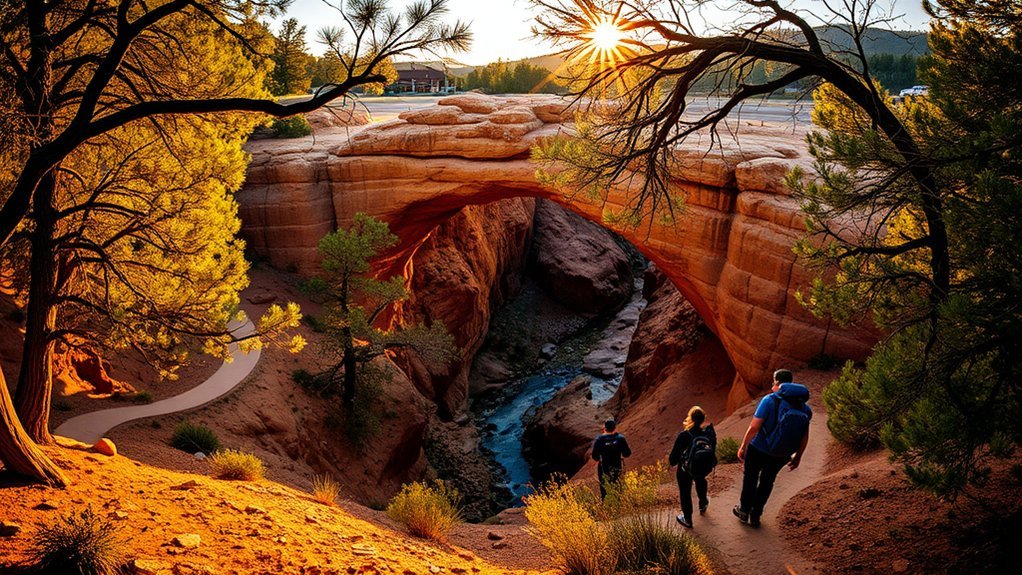
Tonto Natural Bridge State Park sits in central Arizona near Payson, about a 90-minute drive northeast of Phoenix; you’ll reach the park most easily via AZ-87 and Forest Road 300, with clear signage the last several miles. When you arrive, check the park’s website or call ahead for current visitor hours; seasonal changes and special events can alter opening times. Parking is limited, so plan to arrive early during peak season. Park accessibility varies: the main bridge overlook and picnic area are relatively accessible, but trails down into the canyon involve uneven steps and narrow stretches not suitable for wheelchairs. Carry water, wear sturdy shoes, and respect posted closures to guarantee a safe visit.
Short and Easy: Old Highway Loop Trail
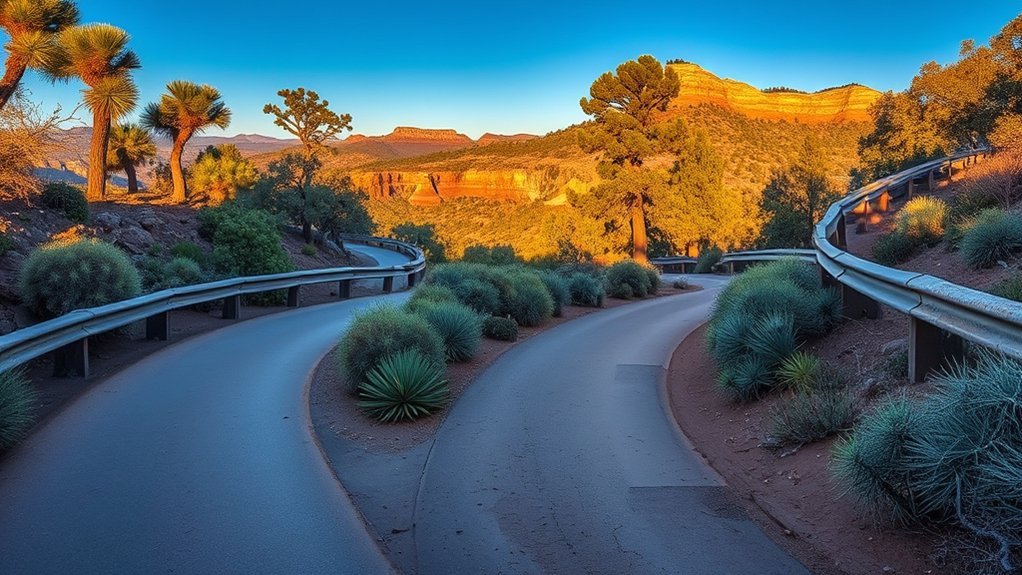
Looking for a short, low-effort way to experience the park’s scenery? The Old Highway Loop Trail is a compact, well-marked circuit that takes about 20–30 minutes at a relaxed pace. You’ll follow packed dirt and gentle grades, so it’s ideal if you want minimal exertion but reliable scenic views without steep climbs. Trail highlights include lookout points over the bridge’s limestone walls, interpretive signs that explain local geology, and benches placed for rest and photos. The path is dog-friendly on leash and accessible for most walkers; wear sturdy shoes for uneven sections. Stay on the trail to protect native plants and avoid cliff edges. It’s a practical choice when you’ve limited time but want a meaningful park experience.
Family-Friendly Walk: Pine Creek Nature Trail
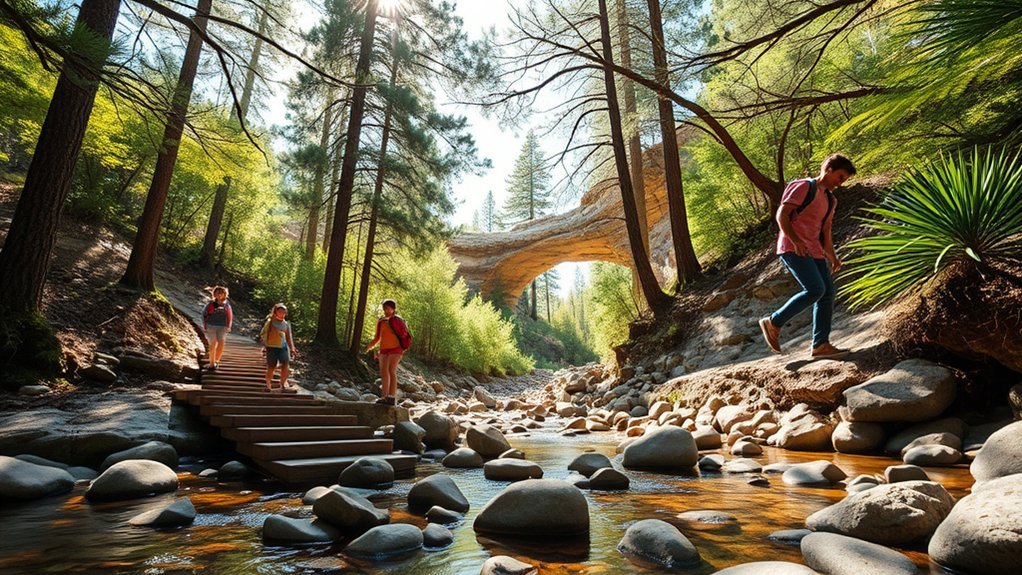
If you want an easy, engaging walk the whole family can enjoy, the Pine Creek Nature Trail delivers about a mile of shaded, well-maintained path that highlights the park’s riparian habitat and native plant life. You’ll follow gentle grades and sturdy boardwalks, so strollers and less steady hikers can keep pace without trouble. Interpretive signs point out cottonwoods, sycamores, and local wildlife, turning a walk into hands-on nature exploration and learning for kids. Benches and overlooks let you pause for snacks and quiet observation, supporting relaxed family bonding. Stay on the marked trail to protect fragile plants and avoid steep drop-offs. Bring water, sun protection, and comfortable shoes; the trail rewards modest effort with a restful, educational outing.
Photo Ops: Bridge Overlook and Fern Alcove Trail
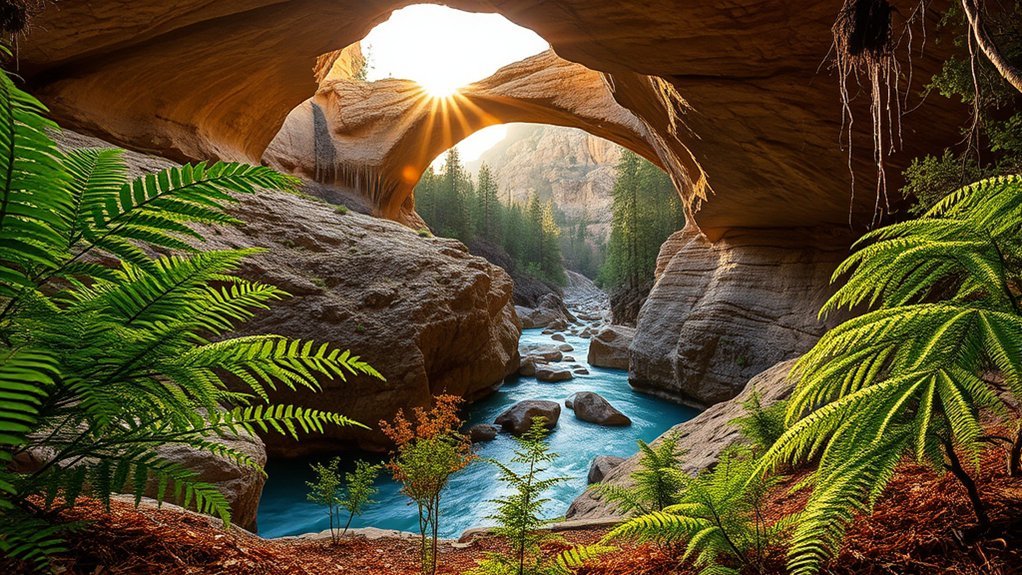
Plan your shoot for golden hour at the Bridge Overlook and mid-morning for the Fern Alcove to get the best light and softer shadows. Bring a wide-angle lens for sweeping views, a macro or telephoto for fern details, and use low ISO with a tripod for long exposures in the shaded alcove. Frame the bridge with leading lines and foreground texture, and try low and high angles to emphasize scale and depth.
Best Times to Shoot
When light matters most, aim for two windows: early morning for soft, directional light at the Bridge Overlook and late afternoon into golden hour for the Fern Alcove Trail’s warm glow and shadow detail. You’ll want to arrive at sunrise to capture the bridge’s texture before crowds and harsh midday contrast appear; fog or lingering moisture after cooler nights can add mood, so plan around seasonal changes. For the Fern Alcove Trail, work the last hour before sunset when backlighting highlights ferns and canyon walls, then stay into blue hour for cooler tones and long exposures if water’s visible. Check sunrise/sunset times, weather forecasts, and park hours; adjust for winter’s shorter days and summer’s intense midday sun to maximize usable light.
Gear and Settings
A compact kit will get you most strong images at Bridge Overlook and Fern Alcove Trail, so bring a versatile zoom (24–70mm or 16–35mm for wider context), a fast prime (35mm or 50mm) for low light and sharp detail, and a sturdy tripod for long exposures and precise composition. Pack hiking essentials: water, layered clothing, sturdy shoes, sun protection, and a small first-aid kit. For gear recommendations, favor weather-sealed bodies, a polarizer to manage reflections, and neutral-density filters for silky water effects. Keep spare batteries and fast cards accessible; cold or long sessions drain power. Use modest ISO (100–400), aperture around f/5.6–11 for depth, and shutter speeds that match motion goals. Stay safe and efficient.
Composition Tips and Angles
Looking for striking compositions at Bridge Overlook and Fern Alcove Trail? You’ll want focused composition techniques to turn scenes into memorable images. At Bridge Overlook, use leading lines—trails, railings, and rock edges—to draw the eye to the arch; vary photo angles by shooting low for grandeur or from the side to emphasize depth. For Fern Alcove Trail, isolate textures and layers: frame ferns with natural archways, use shallow depth to separate foreground fronds from mossy walls, and try backlighting for translucence. In both spots, apply the rule of thirds, negative space, and symmetry selectively. Move deliberately, test multiple photo angles, and refine compositions quickly as light shifts for efficient, impactful results.
Moderate Hike: Upper Canyon Rim Loop
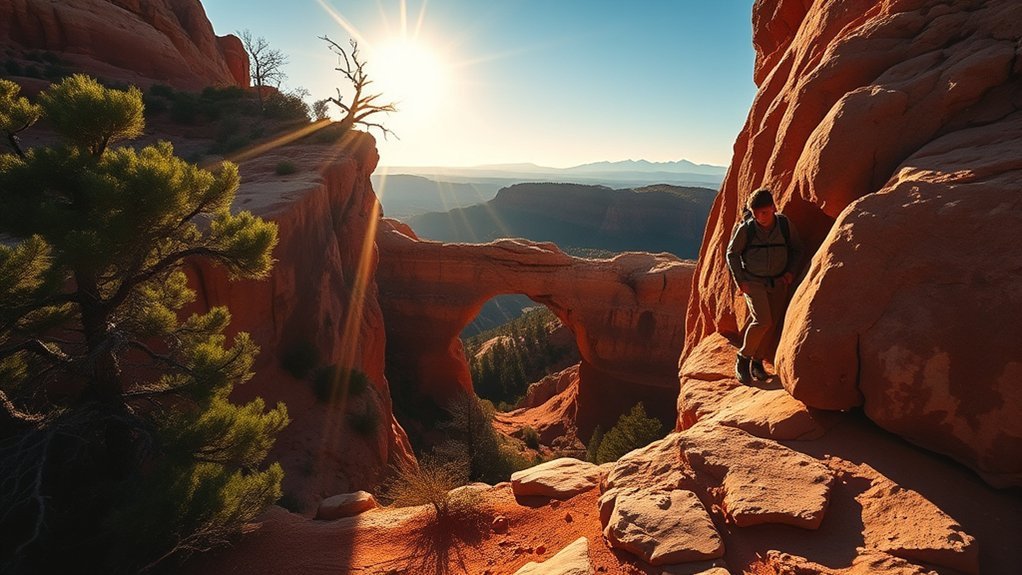
You’ll follow a roughly 1.5-mile loop that stays mostly on the canyon rim, with a few short, rocky sections and modest elevation changes—expect well-marked trails and a steady, moderate pace. Along the route you’ll pass several overlooks, native plant clusters, and a small seasonal waterfall that make excellent stopping points for photos and rest. Bring sturdy shoes and water so you can focus on the views and terrain without turning back early.
Trail Details
Start the Upper Canyon Rim Loop at the main trailhead and follow the well-marked path as it climbs gently along the canyon’s rim, offering panoramic views of the natural bridge and surrounding pine-covered slopes. You’ll encounter mixed trail types—packed dirt, short rock steps, and compacted gravel—and steady trail conditions suitable for most moderately fit hikers. Expect a 2.5–3 mile loop with modest elevation gain, clear signage, and occasional exposed sections that reward focus. Carry water, layered clothing, and sturdy shoes; the route is maintained but can be slick after rain. Use the table below to connect emotionally with the hike’s rhythm and pace.
| Mood | Sensation | Moment |
|---|---|---|
| Calm | Pine scent | Sunrise glow |
| Focused | Footfall | Steep step |
| Awe | Vista | Deep silence |
| Comfort | Warmth | Mid-hike rest |
Points of Interest
After following the rim path and settling into the hike’s pace, take note of several standout features that make the Upper Canyon Rim Loop memorable. You’ll pass layered sandstone overlooks that frame the expansive canyon and highlight uncommon natural formations, including alcoves and small hoodoos worn by wind and water. Look for interpretive signs that explain geology and seasonal water flow. As you round corners, you’ll find shady juniper clusters and brief benches perfect for views or photos. Keep your eyes and ears open for wildlife encounters—lizards basking on rocks, songbirds in the trees, and occasionally mule deer at dawn or dusk. Stick to the trail to protect fragile plant life and preserve these points of interest for others.
Serene Detour: Lower Creekside Trail
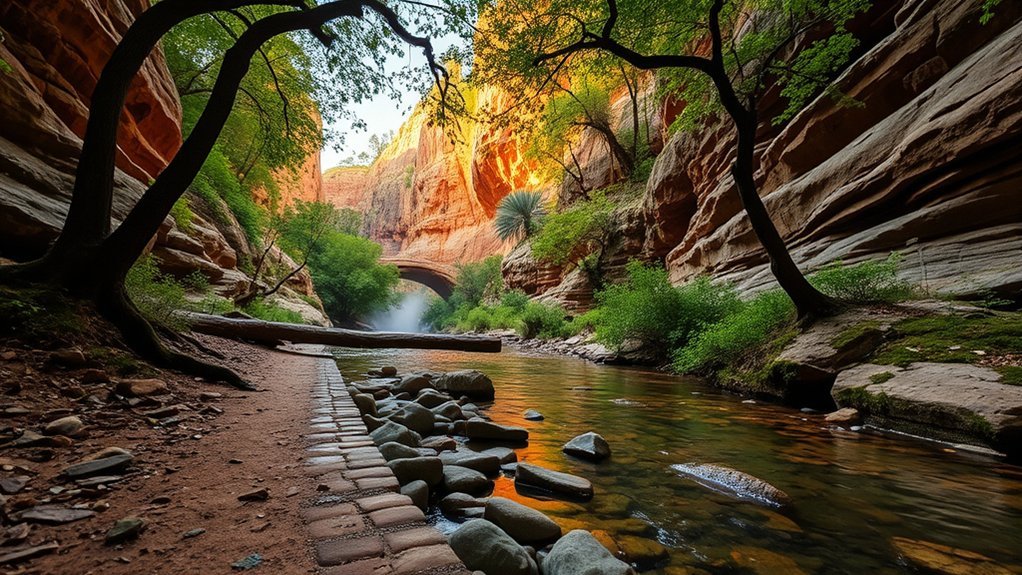
Because it follows the creek below the park’s rim, the Lower Creekside Trail feels like a purposeful detour into quiet riparian habitat where you’ll find cool shade, moss-lined rocks, and close-up views of the bridge’s underbelly. You’ll walk a short, well-marked path that prioritizes creekside tranquility and easy access; footing is generally moderate but can be slick after rain. Expect compacted soil, occasional wooden steps, and clear sightlines that make wildlife observations reliable—songbirds, lizards, and deer are common if you move slowly and respect noise levels. Carry water, wear sturdy shoes, and use a walking stick for confidence on uneven sections. The loop returns you to the main overlook without steep climbs, making it ideal for a reflective half-hour detour.
Challenging Route: South Ridge Scramble
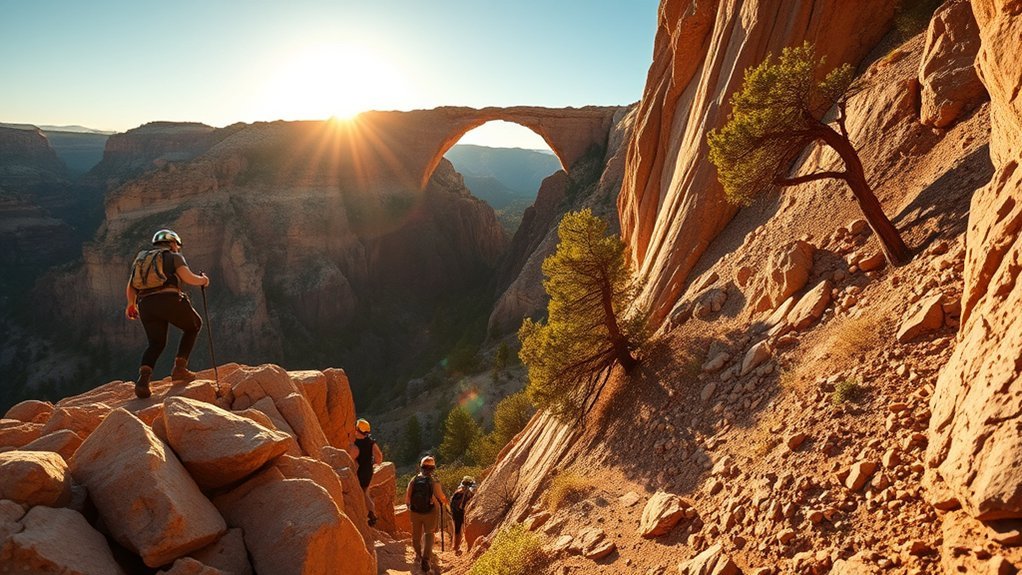
The South Ridge Scramble is a steep, exposed route best suited for experienced hikers comfortable with loose rock and route-finding. You’ll need sturdy boots, a helmet if you plan to scramble, plenty of water, and navigation tools to stay safe. Know your limits, check conditions before you go, and don’t attempt the scramble alone.
Route Difficulty Overview
Expect steep, uneven terrain and several exposed sections on the South Ridge Scramble — this route suits experienced hikers comfortable with loose rock, route-finding, and short hand-and-foot moves. You’ll want to review hike ratings and current trail conditions before you go; difficulty spikes after rain and on loose scree. The scramble demands sustained focus, balance, and confident foot placement over variable surfaces. Elevation gain is moderate but concentrated, with narrow ridgelines and a few class 3 moves where handholds are sparse. Pace yourself, conserve energy for route-finding, and plan extra time for tricky sections. If you’re not regularly tackling off-trail scrambling or traversing faint cairns, consider an easier route; the South Ridge rewards those with solid scrambling experience.
Safety and Gear Essentials
After evaluating the South Ridge Scramble‘s steep, loose sections and occasional class 3 moves, you’ll want to outfit yourself and plan like you’re heading into technical terrain. Prioritize hiking safety: check weather, tell someone your route and ETA, and avoid the scramble when rain or heat make rock unstable. For essential gear bring sturdy boots with sticky rubber, a helmet for rockfall, and trekking poles for balance on approach; stow a lightweight climbing harness and short sling if you expect exposed moves. Pack navigation (map, compass, GPS), headlamp, extra water and a filtration option, and a compact first-aid kit with blister care. Move deliberately, test handholds, and turn back if conditions or your comfort level change.
Birding and Botanical Explorations Along the Creek
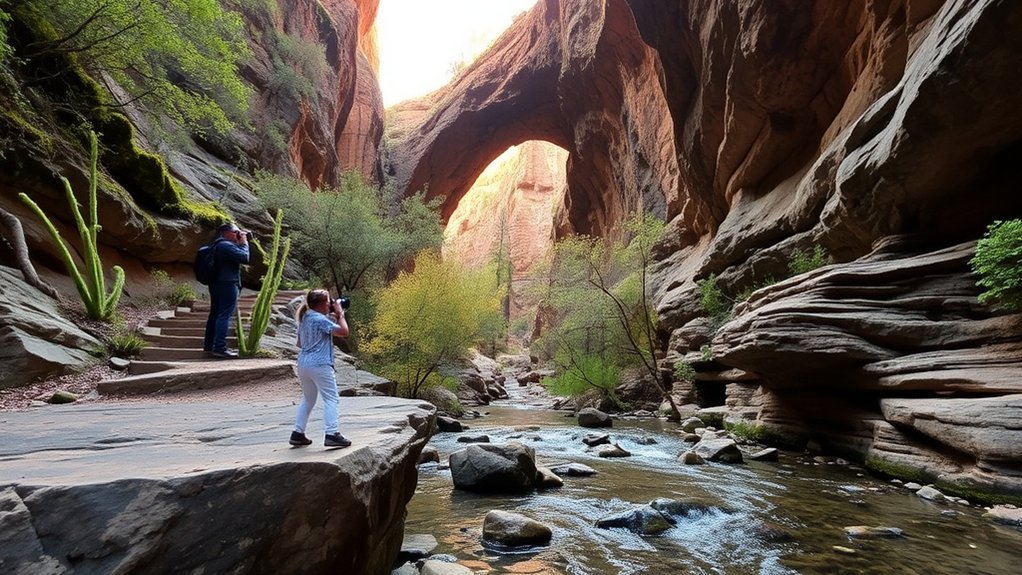
Curious what birds and plants you’ll spot along the creek? You’ll find birdwatching hotspots where riparian trees attract songbirds, raptors, and migrating warblers. Learn to scan canopy and understory; carry binoculars and a field guide. Respect nests and stay on trails to avoid disturbing wildlife.
| Season | Common Birds | Notable Plants |
|---|---|---|
| Spring | Yellow-rumped Warbler, Swainson’s Thrush | Cottonwood, Willow |
| Summer | Vermilion Flycatcher, Red-tailed Hawk | Desert Lavender, Globe Mallow |
| Winter | American Kestrel, White-crowned Sparrow | Yerba Mansa, Native plants like sedge |
Note bird timing varies; document sightings and learn plant ID—particularly native plants that support insect and bird life.
Backcountry Tips: Safety, Leave No Trace, and Permits
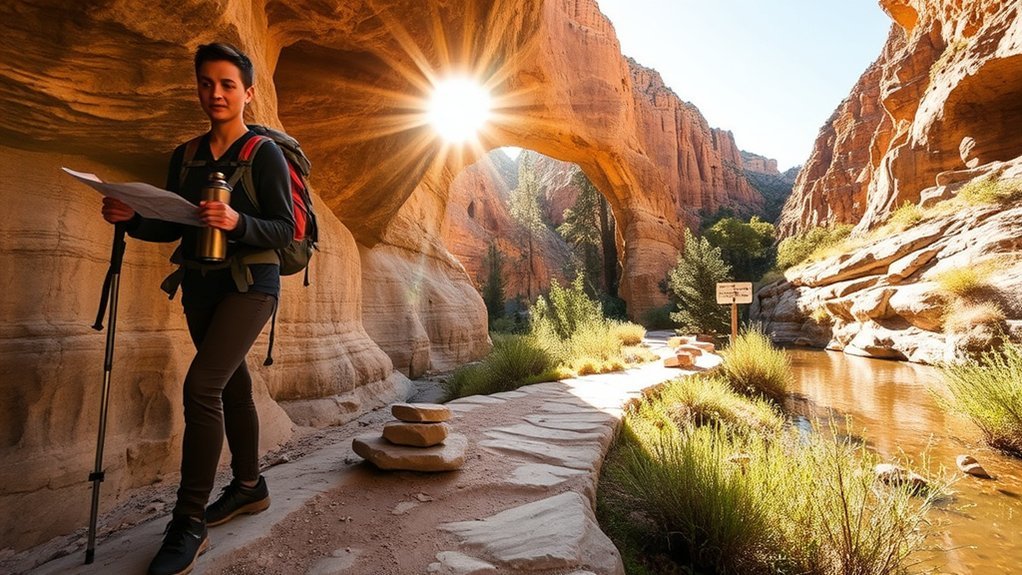
Because backcountry conditions can change quickly, you should prepare before you go by checking weather, trail advisories, and permit requirements; pack navigation tools, extra water, a basic first-aid kit, and layers, and tell someone your route and expected return. You’ll rely on solid backcountry navigation—map, compass, GPS—and know how to use them. Practice low-impact camping and pack out all waste to follow Leave No Trace. Anticipate wildlife encounters: store food properly, keep distance, and never feed animals. Obtain required permits ahead of time and display or carry them as instructed.
Prepare thoroughly: check conditions and permits, pack navigation, water, first aid and layers, tell someone your route.
- Know route, carry redundant navigation tools, and plan bailout options.
- Carry water treatment and extra hydration.
- Follow Leave No Trace: camp, cook, and dispose responsibly.
- Secure food, respect wildlife, and report issues.
Best Times to Visit and Seasonal Considerations
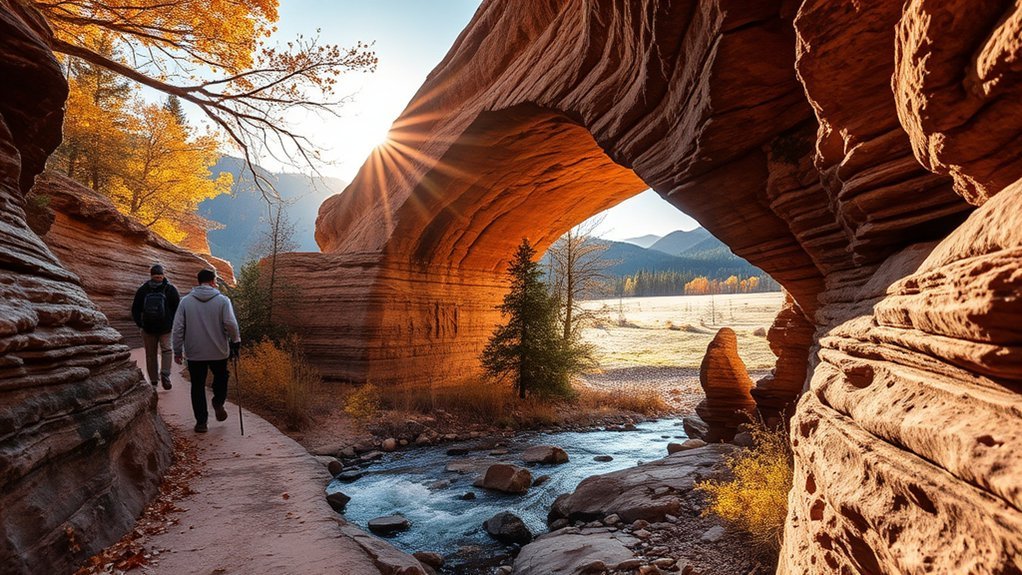
If you want the most comfortable hiking conditions and the best light for photos, plan your visit for spring (March–May) or fall (late September–November), when daytime temperatures are mild and trails are less likely to be affected by extreme heat or monsoon storms. You’ll avoid extreme seasonal weather and enjoy wildflowers or changing foliage. Summer brings high heat and limited shade; winter can be cool and occasionally icy. Peak visitation occurs in spring and fall, so arrive early or visit weekdays to secure parking and solitude. Check forecasts and park alerts for flash flood risks during monsoon season. Use the table below to compare trade-offs quickly.
| Season | Key Consideration |
|---|---|
| Spring | Mild, wildflowers |
| Summer | Heat, low water |
| Fall | Mild, fewer storms |
| Winter | Cooler, fewer crowds |
Frequently Asked Questions
Are Dogs Allowed Anywhere in the Park?
Yes — you can bring dogs on park trails and areas where allowed; follow dog policies, keep pets leashed, and supervise them. You’ll protect pet safety by packing water, cleaning waste, and avoiding fragile areas or wildlife encounters.
Is There Cell Phone Reception Inside the Canyon?
Barely — you’ll feel like you’re yelling at the sky; cell coverage inside the canyon is spotty. You should plan for no service, verify canyon accessibility beforehand, and carry offline maps, emergency contacts, and backup communication.
Are There Guided Tours or Ranger-Led Programs?
Yes — you’ll find guided hike options and ranger programs availability seasonally; check the park’s schedule online or at the visitor center. You’ll get expert-led interpretation, safety guidance, and occasional special-topic walks or talks.
Is Fishing Permitted in the Creek?
Yes — you can fish in the creek, but you’ll follow Arizona fishing regulations and park rules; check current creek conditions, seasonal closures, and required licenses, and practice catch-and-release or size limits to protect native species.
Are There Nearby Lodging or Camping Options?
Yes — you’ll find primitive camping facilities at nearby state park areas and several nearby hotels in Payson and Pine offering comfortable rooms. Check reservations, seasonal availability, and park regulations before planning your stay.
Conclusion
You’ll leave Tonto Natural Bridge with more than photos — the trails become a compass, each step a thread stitching sky to stone. Let the Old Highway Loop steady your pace, the Rim Loop broaden your view, and the South Ridge sharpen your courage. Respect the creek’s quiet lessons: pack lightly, tread softly, and follow park rules. Return often; like the bridge itself, these paths connect you to something older and steadier than day-to-day life.

